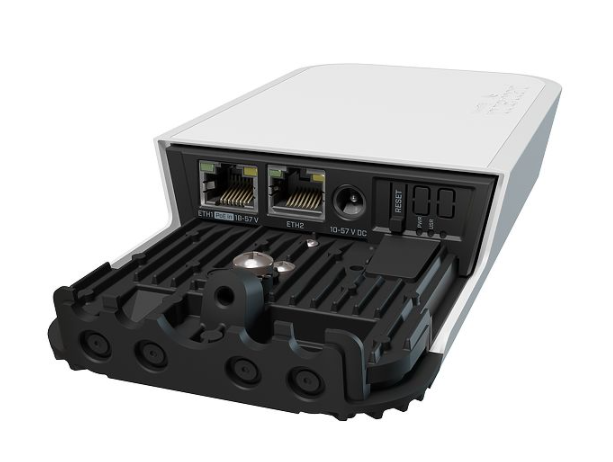...
- Make sure your Internet service provider is allowing hardware change and will issue an IP address.
- Open the bottom lid.
- Plug the included PoE injector into the ISP outlet and attach an Ethernet cable to it.
- Connect the other end of the Ethernet cable to this router.
- Plug the provided power supply into the PoE injector.
- Connect your computer to the wireless network.
- Open https://192.168.88.1 in your web browser to start the configuration.
- User name: admin and there is no password by default (or, for some models, check user and wireless passwords on the sticker)..
- You will be logged in to the configuration screen.
- Click the "Check_for_updates" button on the right side and update your RouterOS software to the latest version. Must have an active Internet connection.
- The device will reboot.
- Connect again and choose your country on the left side of the screen, to apply country regulation settings.
- Set up your wireless network password, the password must be at least eight symbols.
- Set the Installation to indoors or outdoors, depending on the usage type.
- Set up your router password in the bottom field to the right and repeat it, it will be used to login next time.
...
Expansion slots and ports
- Integrated two Wireless modules operating at 2.4 GHz and 5 GHz, supporting AP/CPE/P2P/repeater modes.
- Two 10/100/1000 Ethernet ports, supporting automatic cross/straight cable correction (Auto MDI/X). Either straight or crossover cable can be used for connecting to other network devices.
...
The device supports RouterOS software with the version number at or above what is indicated in the RouterOS menu /system resource. Other operating systems have not been tested.
Notice
- The Frequency band 5.470-5.725 GHz isn’t allowed for commercial use.
- In case WLAN devices work with different ranges than the above regulations, then a customized firmware version from the manufacturer/supplier is required to be applied to the end-user equipment and also prevent the end-user from reconfiguration.
- For Outdoor Usage: End-user requires approval/license from the NTRA.
- Datasheet for any device is available on the official manufacturer website.
- Products with the letters “EG” at the end of their serial number have their wireless frequency range limited to 2.400 – 2.4835 GHz, the TX power is limited to 20dBm (EIRP).
- Products with the letters “EG” at the end of their serial number have their wireless frequency range limited to 5.150 – 5.250 GHz, the TX power is limited to 23dBm (EIRP).
- Products with the letters “EG” at the end of their serial number have their wireless frequency range limited to 5.250 – 5.350 GHz, the TX power is limited to 20dBm (EIRP).
| Info |
|---|
Please make sure the device has a lock package (firmware version from the manufacturer) which is required to be applied to the end-user equipment to prevent the end-user from reconfiguration. The product will be marked with country code “-EG”. This device needs to be upgraded to the latest version to ensure compliance with local authority regulations! It is the end users responsibility to follow local country regulations, including operation within legal frequency channels, output power, cabling requirements, and Dynamic Frequency Selection (DFS) requirements. All MikroTik radio devices must be professionally installed. |
Accessories
| Note |
|---|
To avoid pollution of the environment, please separate the device from household waste and dispose of it in a safe manner, such as in designated waste disposal sites. Familiarize yourself with the procedures for the proper transportation of the equipment to the designated disposal sites in your area. |
...
UKCA Marking
Eurasian Conformity Mark
Частотный каналы | Мощность передатчика |
|---|---|
| 2400-2483.5 МГц, 5150-5350 МГц, 5650-5850 МГц | ≤10 Вт |
*Доступные частотные каналы могут различаться в зависимости от модели продукта и сертификации.
...
Frequency bands terms of use
Frequency range (for applicable models) | Channels used | Maximum Output Power (EIRP) | Restriction |
2400-2483.5 MHz | 1 - 13 | 20 dBm | Without any restriction to use in all EU Member States |
5150-5250 MHz | 26 - 48 | 23 dBm | Restricted to indoor use only* |
5250-5350 MHz | 52 - 64 | 20 dBm | Restricted to indoor use only* |
5470-5725 MHz | 100 - 140 | 27 dBm | Without any restriction to use in all EU Member States |
* It is the customer's responsibility to follow local country regulations, including operation within legal frequency channels, output power, cabling requirements, and Dynamic Frequency Selection (DFS) requirements. All Mikrotik radio devices must be professionally installed!
...


